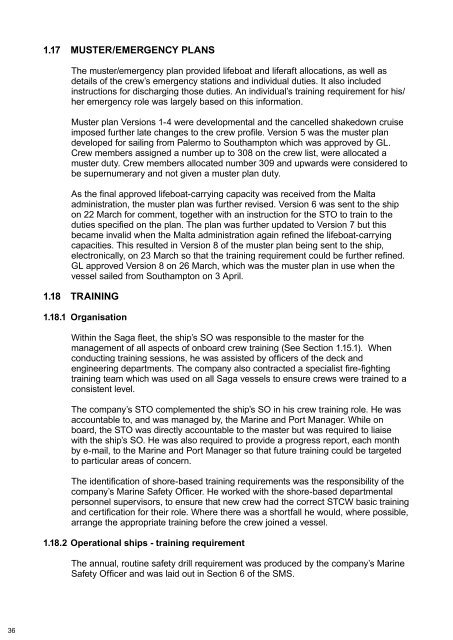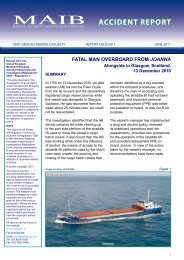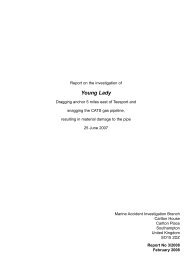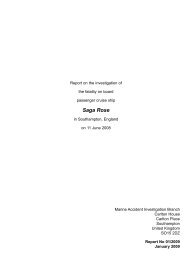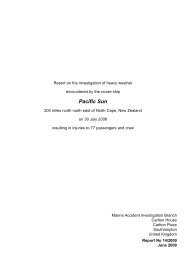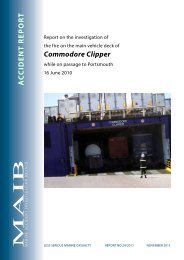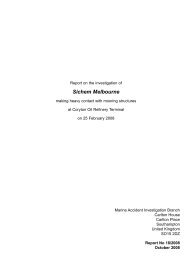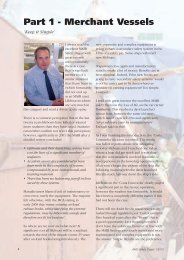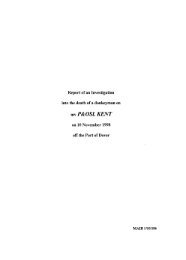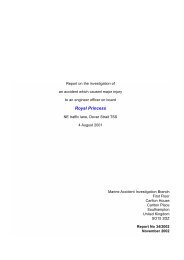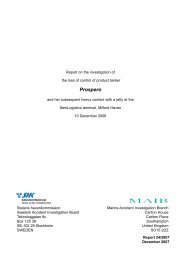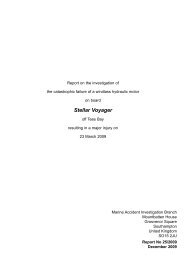SECTION 4 - Marine Accident Investigation Branch
SECTION 4 - Marine Accident Investigation Branch
SECTION 4 - Marine Accident Investigation Branch
You also want an ePaper? Increase the reach of your titles
YUMPU automatically turns print PDFs into web optimized ePapers that Google loves.
36<br />
1.17 MUSTER/EMERGENCY PLANS<br />
The muster/emergency plan provided lifeboat and liferaft allocations, as well as<br />
details of the crew’s emergency stations and individual duties. It also included<br />
instructions for discharging those duties. An individual’s training requirement for his/<br />
her emergency role was largely based on this information.<br />
Muster plan Versions 1-4 were developmental and the cancelled shakedown cruise<br />
imposed further late changes to the crew profile. Version 5 was the muster plan<br />
developed for sailing from Palermo to Southampton which was approved by GL.<br />
Crew members assigned a number up to 308 on the crew list, were allocated a<br />
muster duty. Crew members allocated number 309 and upwards were considered to<br />
be supernumerary and not given a muster plan duty.<br />
As the final approved lifeboat-carrying capacity was received from the Malta<br />
administration, the muster plan was further revised. Version 6 was sent to the ship<br />
on 22 March for comment, together with an instruction for the STO to train to the<br />
duties specified on the plan. The plan was further updated to Version 7 but this<br />
became invalid when the Malta administration again refined the lifeboat-carrying<br />
capacities. This resulted in Version 8 of the muster plan being sent to the ship,<br />
electronically, on 23 March so that the training requirement could be further refined.<br />
GL approved Version 8 on 26 March, which was the muster plan in use when the<br />
vessel sailed from Southampton on 3 April.<br />
1.18 TRAINING<br />
1.18.1 Organisation<br />
Within the Saga fleet, the ship’s SO was responsible to the master for the<br />
management of all aspects of onboard crew training (See Section 1.15.1). When<br />
conducting training sessions, he was assisted by officers of the deck and<br />
engineering departments. The company also contracted a specialist fire-fighting<br />
training team which was used on all Saga vessels to ensure crews were trained to a<br />
consistent level.<br />
The company’s STO complemented the ship’s SO in his crew training role. He was<br />
accountable to, and was managed by, the <strong>Marine</strong> and Port Manager. While on<br />
board, the STO was directly accountable to the master but was required to liaise<br />
with the ship’s SO. He was also required to provide a progress report, each month<br />
by e-mail, to the <strong>Marine</strong> and Port Manager so that future training could be targeted<br />
to particular areas of concern.<br />
The identification of shore-based training requirements was the responsibility of the<br />
company’s <strong>Marine</strong> Safety Officer. He worked with the shore-based departmental<br />
personnel supervisors, to ensure that new crew had the correct STCW basic training<br />
and certification for their role. Where there was a shortfall he would, where possible,<br />
arrange the appropriate training before the crew joined a vessel.<br />
1.18.2 Operational ships - training requirement<br />
The annual, routine safety drill requirement was produced by the company’s <strong>Marine</strong><br />
Safety Officer and was laid out in Section 6 of the SMS.


